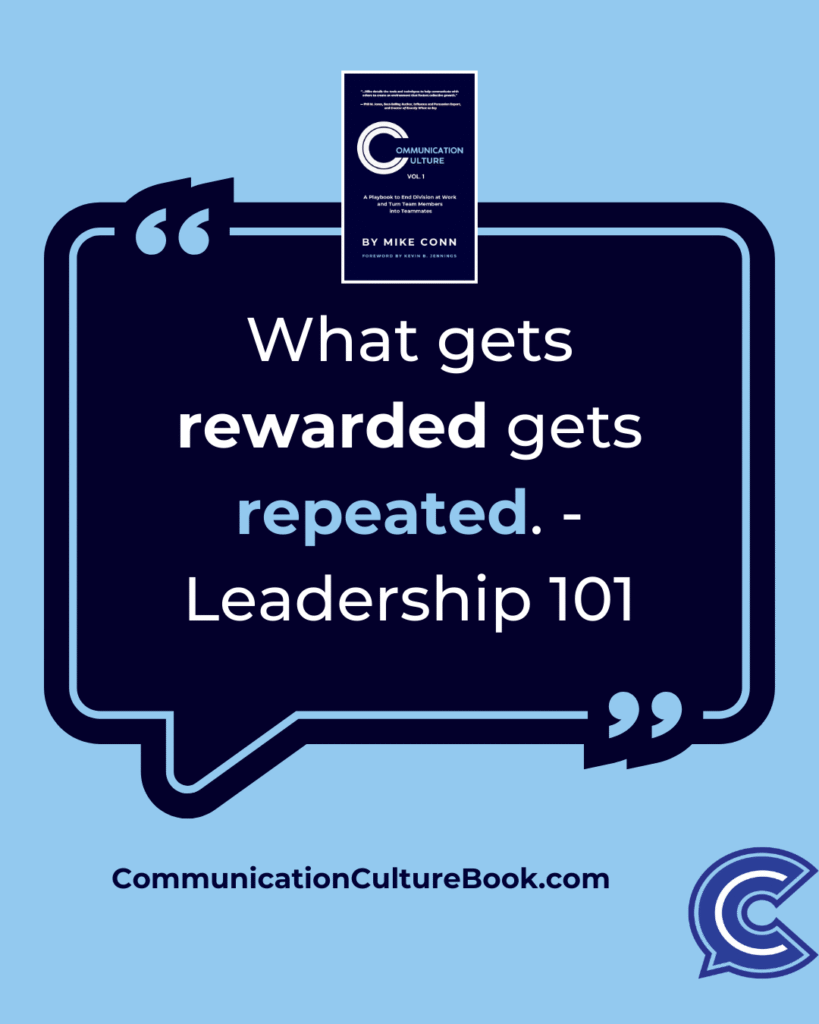What is your experience following a leader whose leadership didn’t match their message?
How certain are you that your leadership team’s actions align with the mission and values of your organization?
What do you understand about how what leaders recognize and reward affects team performance and morale?
What is your experience working under a leader who said one thing but recognized and rewarded something different?
How did that make you feel?
Most leaders want to believe they are reinforcing the right behaviors. But could it be possible that what you’re actually recognizing and rewarding is not what you say you value?
How would you feel if you found out your team was disengaged not because they don’t care—but because they’re confused about what truly matters?
When was the last time you evaluated your recognition and rewards to make sure they align with the culture you want to create?
Because here’s the reality:
Nobody Gets ISO 9000 Certified Because of Their Mission Statement
Culture is not your mission statement.
Culture is not your handbook.
Culture is not what you say in meetings.
Culture is how you do things and what you allow to happen.
To get ISO 9000 Certified, organizations must prove that their actions match their words—with documentation and audits. When I worked as a quality inspector for a mortgage processing company, I saw this firsthand. We had to show that what we said we did was actually what we did. It was eye-opening.
Your culture works the same way. It’s shaped every day by the behaviors you recognize, reward, and tolerate. And when what you recognize and reward doesn’t match what you claim to value, people notice.
That’s where Leadership 101 comes in:
What Gets Rewarded Gets Repeated
If you recognize and reward collaboration, teamwork, and knowledge-sharing—those behaviors will grow.
If you only recognize and reward hitting numbers at any cost, people will prioritize results over relationships, and your culture will shift.
But here’s the problem—many leaders miss a huge blind spot.
Blindspot Alert: What Are You Actually Recognizing and Rewarding?
We’ve all stepped in something we didn’t see coming.
The same is true in leadership. Even with the best intentions, if what you recognize and reward doesn’t match your stated values, you create confusion, disengagement, and resentment.
🚨 Blindspot Alert: If the person being nominated for recognition receives a bigger reward than the person making the nomination, you’re sending the message that recognizing great work is less valuable than producing it.
Think about that.
Recognition isn’t just about formal awards or bonuses. Every interaction is a form of reward.
llamcorper mattis, pulvinar dapibus leo.
- Time – Who gets the most coaching and development? Who has more access to leadership?
- Attention – Who gets recognized in meetings? Who gets called out (positively or negatively)?
- Incentives – Do bonuses, promotions, or perks reinforce the right behaviors—or just the easiest to measure?
Most organizations introduce peer-nominated awards to encourage teamwork. But if the person doing the nominating isn’t valued as much as the one being nominated, what message does that send?
Here’s the good news: You don’t need to rebuild your system—just optimize what’s already in place.
Three Forms of Motivation—And How They Shape Your Culture
If you want to build trust, engagement, and high performance, you need to understand why people do what they do.
Every decision a person makes is driven by one (or more) of these three motivations:
1
Running Toward Comfort
Wanting to make life easier, more enjoyable, or more rewarding.2
Running Away from Discomfort
Avoiding fear, insecurity, or failure.3
Self-Driven Motivation
Seeking personal growth, recognition, or success.They all work. But strong cultures don’t rely on just one.
If you want to build a workplace where people thrive, you need to:
- Make recognition comfortable - Ex: Regularly acknowledge contributions, provide job security, and give clear feedback.
- Reduce uncertainty - Ex: If people don’t know what’s valued, they play it safe instead of contributing fully.
- Show why it’s worth it - Ex: A culture built on trust, recognition, and respect leads to success for everyone.
When you get this right, your team strives for excellence—not because they have to, but because they want to.
How Do Leaders Align What Recognize with the Culture They Want to Have?
Culture isn’t what you intend to build—it’s what you reinforce daily.
Here’s how to ensure recognition and rewards match your mission:
1. Identify the Behaviors You Actually Want to See
If you’re only recognizing and rewarding results, you may be devaluing the process that gets you there.
Ask yourself:
✅ Do we only recognize achievements, or do we also reward teamwork, problem-solving, and innovation?
✅ Are we celebrating individuals in a way that strengthens the team, or are we creating competition?
Clarifying the exact behaviors that align with your mission is the first step in reinforcing them.
2. Make Recognition a Daily Habit
Culture isn’t built in an annual awards ceremony—it’s built in daily interactions.
Not everyone wants to be recognized in the same way. Some prefer public praise, while others appreciate a private thank-you. Personalizing recognition makes it more meaningful.
Would it be helpful if you had a simple way to ensure recognition became part of your team’s daily rhythm?
Here’s one: Encourage peer-to-peer recognition with:
✅ Weekly shoutouts in team meetings
✅ Digital kudos for problem-solving or teamwork
✅ Informal thank-you notes or Slack messages
When employees start actively looking for great work in others, they become more engaged in the team’s success—and that engagement produces results.
3. Align Recognition and Rewards with Values
If your company says it values teamwork but only rewards individual success, you create a cultural disconnect.
The easiest way to fix this? Match your recognition and rewards to your values.
A simple adjustment—like ensuring the nominator and nominee receive equal rewards—immediately shifts the focus from individual success to team success.
This small change:
✅ Increases engagement
✅ Strengthens trust within teams
✅ Creates a culture where recognition is as valuable as results
Bringing It All Together: Your Leadership Choice
If it sounds like a lot of work, that’s because it is.
But if leaders take the time to make their teams feel valued and appreciated, the morale and culture will eclipse even the highest production.
✅ Recognize and reward the right behaviors → Strengthen culture, communication, and engagement.
❌ Ignore it → Risk high turnover, burnout, and a disconnected team.
Leadership isn’t just about setting goals—it’s about shaping culture.
Because if you don’t, you’ll pay for it in ways you can’t afford.
Let’s Connect & Elevate Your Team’s Culture
Building a culture where people feel valued, supported, and inspired takes intentional leadership and the right tools.
📖 Want to equip your team with actionable strategies to strengthen culture and communication? Get your copies of Communication Culture Vol. 1 at CommunicationCultureBook.com—perfect for team discussions, leadership development, and creating a workplace where recognition and rewards align with your values.
📲 Let’s keep the conversation going! Follow me on Instagram @soldoutmike for daily leadership insights, practical communication strategies, and real-world examples of how recognition transforms workplace culture.











